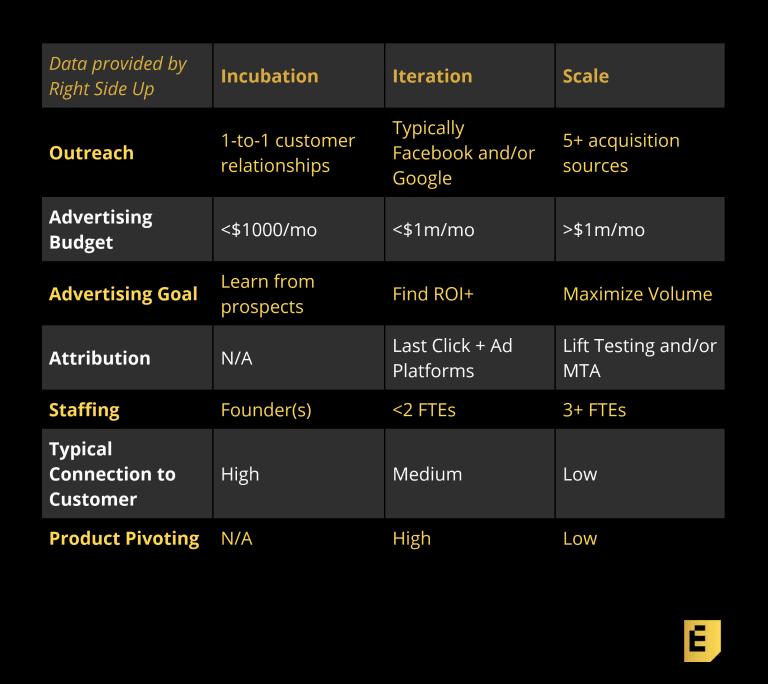How should B2B startups think about growth? Not like B2C – TechCrunch
Curated from: techcrunch.com
Ideas, facts & insights covering these topics:
10 ideas
·266 reads
Explore the World's Best Ideas
Join today and uncover 100+ curated journeys from 50+ topics. Unlock access to our mobile app with extensive features.
What growth stage is your B2B startup?
Incubation: build your minimum viable product (MVP) in close partnership with potential customers to ensure you are solving a real problem with a credible solution.
Iteration: have customers using your MVP and are rapidly improving the product. Success at this stage is rooted in customer insights – both qualitative and quantitative – not marketing excellence
Scale: have product/market fit and are trying to grow your customer base. The goal of this phase is to build a portfolio of tactics that maximize market penetration with minimal – or at least profitable – cost
5
45 reads
Success is rooted in growing lifetime value through retention and margin, maximizing funnel conversion to efficiently convert leads to customers, and finding repeatable tactics
TYLER ELLISTON, KEVIN BARRY
5
40 reads
How do you find B2B customers? 1/2
Leverage your network. This is particularly valuable for founders who are building a product based on their own past experience.
Cold calling (or showing up in person). Knock on doors, make phone calls. You have to get used to hearing “no”, but you’d be surprised how often you can get people to try your product once you have a personal connection. A big advantage of paid digital is that you get results immediately.
Paid digital. Facebook and Google make up 90%+ of all new online ad spend these 2 channels are generally the best place to start testing online advertising
4
33 reads
B2B customer acquisition tactics 2/2
Paid physical. It’s more expensive to get in front of each person, but you can choose exactly who gets your mail so you only show up in front of people who qualify for and want your product.
Events. For almost any industry, there are events and trade shows where you can find customers.
Content Marketing and SEO. Content marketing means writing articles and creating content to get in front of people searching for information about your product category.
4
30 reads
When do you use which channels?
For Incubation…
In this stage, you’ll be doing a lot of manual outreach to get your first paying customers, and improving the product based on feedback. The channels above most often used in this stage are leveraging your network, cold calling, cold email/LinkedIn outreach, and going to events.
You don’t need much marketing budget in the innovation period, assuming you’re using your own labor for all this outreach. $500 per month to afford tools like Clearbit (to get lists), Reply.IO (To help with cold email) and LinkedIn Pro (To send messages on LinkedIn) should be fine.
4
21 reads
For Iteration…
In this stage, you want to get more strangers outside of your network and social circles to try your product.
This means an expanded focus on cold calling, email, and outreach. It also means you can start paid digital ads on Facebook and Google. This will help you learn more about what messaging brings in potential customers. For instance, you can find out things like which of your product’s features customers like more by putting different features in different ads and seeing which ad gets higher click-through rates.
4
18 reads
For Scaling…
Paid digital, paid physical and content/SEO are the three channels that offer the greatest scale for B2B companies. If you build a strong sales team, cold email and cold calling can both scale, but this involves building out a serious sales organization.
The easiest channel to start testing is paid digital because it has the fastest time to get results and the smallest investment needed. You still need a minimum of $5k test to spend in paid digital, and in reality closer to $20k, to get a good idea of long-term cost per conversion.
4
19 reads
What kind of marketing messaging should you use?
Generally, if you’re targeting companies with 10 or fewer employees, use ad messaging that directly promotes your product.
For any kind of ad you build, use the SUCCESS framework.
If you’re targeting companies with 10-10,000+ employees, use marketing messaging that promotes resources closely related to your project. Resources are eBooks, guides, tools, and things that are useful to customers that are related to the product you’re selling but are not actually your product.
- Simple
- Unexpected
- Credible
- Concrete
- Emotional
- Stories
5
17 reads
How do you build your sales funnel?
- Create an automated sales nurture flow that comes from a sales account.
- Create a marketing nurture funnel – usually with email – for people who fall out of the sales funnel after a month. A marketing nurture funnel is like the sales funnel, but is usually less “salesy”. A good example would be subscribing someone to a useful monthly newsletter.
- Create a task-based system to organize sales calls. The faster you call people after they submit their lead information, the more likely they will convert.
4
20 reads
How should you calculate and use the ROI of your marketing budget?
- Lifetime value – Most people do this by calculating out monthly churn (how many customers leave every month) and using that to determine how long customers will keep paying for your product.
- Cost of your sales team – Some B2B products require extensive human engagement. In such cases, marketing will need lower CAC thresholds.
- Vintage periods – For many B2B products, the answer is anywhere from 7 days to 7 months. To calculate the return on your ad spending, you have to track what results came from a given month’s spend, no matter when those sales close down the line.
4
23 reads
IDEAS CURATED BY
Karla Brown's ideas are part of this journey:
Learn more about business with this collection
How to create a positive work environment
Techniques for cultivating gratitude and mindfulness at work
How to find purpose in your work
Related collections
Similar ideas
3 ideas
9 ideas
A Guide to Finding Awesome Co-Founders
medium.com
Read & Learn
20x Faster
without
deepstash
with
deepstash
with
deepstash
Personalized microlearning
—
100+ Learning Journeys
—
Access to 200,000+ ideas
—
Access to the mobile app
—
Unlimited idea saving
—
—
Unlimited history
—
—
Unlimited listening to ideas
—
—
Downloading & offline access
—
—
Supercharge your mind with one idea per day
Enter your email and spend 1 minute every day to learn something new.
I agree to receive email updates






